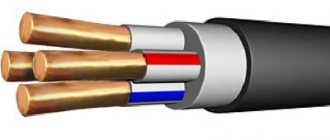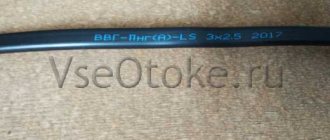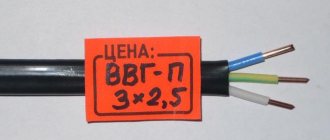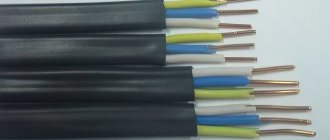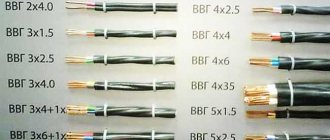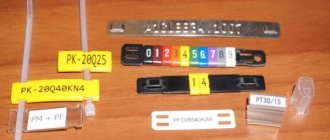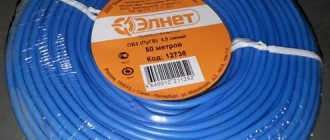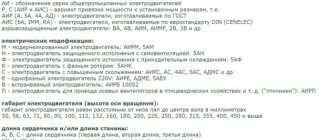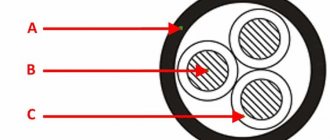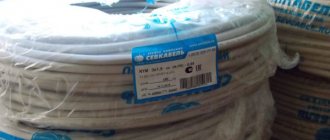Features of the VVGng-LS cable, 8 varieties of the VVG family. Full explanation of the name, gasket options, as well as the 3 best manufacturers. Review of 4 common mistakes. 18 types of power copper cables and approximate prices
TEST:
To understand whether you have sufficient information about the VVGng-LS cable and its purpose, take a short test:
- What causes heavy smoke to form when there is a fire in a building structure?
a) Insulation of cables running in walls.
b) Plaster covering the walls - due to the large amount of flammable materials in the composition.
- What do the letters LS at the end of the wire marking mean?
a) English Little Smoke.
b) English Low Smoke.
- In what case does the cable successfully pass all tests and be allowed into production?
a) When, when recreating real fire conditions, a cable that caught fire reduced the transparency inside the room by no more than 40%.
b) When workers conducted a computer simulation of a fire and smoke reduced the transparency inside the room recreated by the machine by no more than 40%.
c) Upon successful completion of the simulator and real conditions.
- What exactly ensures a reduced fire hazard of the cable?
a) Special NG spray (non-flammable) covering the cable.
b) PVC plastic covering the wire.
Answers:
- a) Strong smoke occurs due to the fire of the cable insulation layer.
- b) The designation LS is the English Low Smoke, which translates as “light smoke”.
- a) To carry out inspections, employees of cable manufacturing enterprises recreate exclusively real fire conditions where the cable is placed. The process uses a special device that detects changes in the transparency of the room due to smoke. If the indicator stops within 40%, then the cable is allowed to be used for installation in a real building.
- b) To reduce the level of fire hazard, cable manufacturers use special PVC plastic to cover the wire.
VVGng
A cable or wire with the designation VVGng LS is the best development of the family of all cable products bearing the abbreviation VVG. The secret of its popularity is the addition of the letters LS. To understand the meaning of the designation and the function of the cable, it is necessary to analyze this issue in detail.
Definition: Cable VVGng-LS is a conductor of electric current that can be laid openly in objects prone to fire.
When a fire occurs in a room, various smoke effects can occur, and when evacuating, people will simply suffocate from harmful smoke.
If a fire breaks out in a building, then it is the cables and various wires that in most cases become the main cause of the source of this smoke.
For safe operation, we have developed a special GOST R 5315-2009 - this is what they are guided by when laying cables. The marking “ng” indicates non-propagation of fire. They also added a special coating that produces low smoke and gas emissions if the cable catches fire.
7 explanations of the cable designation.
It is difficult for an ignorant person to determine what exactly the letters (VVGng LS) on the cable mean. To clarify this situation, you need to study the following transcript:
- VVGng ALS. Explanation of the letter A – flame retardation class according to GOST IEC 60332-3-22-2011. Explanation of the cable designation VVGNG and ls - aluminum wire with reduced gas and smoke emission.
- When the cable does not have the letter A at the beginning of the marking printed on the surface, this means that it has a copper structure.
- The first B indicates a special layer located on the outside and consisting of PVC material.
- The second B means the insulation of the internal conductors, consisting of PVC.
- The abbreviation NG means non-propagation of fire if a group or single gasket was installed.
- LS stands for Low Smoke in English. If translated into Russian, it will mean “light smoke.”
- Explanation of the coolant marking - single-core wire. If there is no such sign on the wire, then the cable is multi-core.
Transcripts
If the VVGng cable has the designation LS separated by a hyphen, this means a guarantee of low smoke and gas emissions when the wire catches fire.
The marking is only placed on the cable if successful testing has been carried out. To study the standard procedures for all tests that cables undergo for smoke generation, it is necessary to study GOST R IEC 61034-1(2)-2005.
To test for the above requirements, fire conditions are recreated inside the laboratory room - the cable is ignited, and then specially trained laboratory technicians measure the transparency of the air in this room. Measurements are carried out both after the wire is ignited and before under normal conditions.
Smoke will reduce the light transmission of the object, this is recorded by clearly tuned instruments. As a result of the test, workers will calculate the ratio of light transmittance after and before the experiment.
All indicators will be expressed exclusively as a percentage. According to GOST R 53769-2010, it is generally accepted that the cable will successfully pass the test if smoke has reduced the transparency inside the room by no more than 40%. Only in this case will the cable be set to LS.
To insulate the VVGng LS cable, PVC plastic is used, which leads to a reduced fire hazard. As a result of contact with fire, the insulation will emit a small amount of smoke. Manufacturers ensure that the resulting smoke is not toxic. This figure should be no more than 40 milligrams per cubic meter, according to GOST R 53769-2010.
The task is very difficult, but cable manufacturers have successfully coped with it using various specialized additives called additives and antipyrine.
Important! Such plastic compounds are used not only in Russia, but also abroad.
Russian manufacturers were able to successfully register several technical specifications (technical conditions that meet the requirements) - TU 2246-001-25795756-2009. They are used to produce the necessary plastic compounds, which are made specifically for insulating cores as internal and external filling.
Marking of cables and wires
6 structural features of the VVGng-LS cable
The location and composition of all elements of the VVG cable are very similar to its other counterparts, which have the same copper cores and a PVC insulating sheath.
For manufacturing, GOST R 53769-2010 is used.
The cable can be flat or round in shape and has a large number of veins inside.
The maximum number of cores is five.
The cores are made stranded, single-wire, sector or round.
To select the nominal values of the cross-sectional area, you need to use a single standard series.
Technical characteristics of VVGng LS:
Absolutely all characteristics of cables with PVC coating are standardized according to GOST R 53769-2010.
There are still slight variations in characteristics due to different manufacturing plants.
Important! The standard will not include indicators of the cross-section and shape of the cores, shell thickness, current resistance - all this applies to the general range of PVC plastic compounds. Only values applicable to insulation consisting of cross-linked polyethylene will be indicated separately.
According to GOST 53769-2010, the maximum tensile strength of the LS product may be slightly different from other types - it may be lower than that of VVG, but not different from that of VVGng.
It is also important to know 3 nuances about laying VVG cables
There are different ways to lay wires into the room:
- Open. Open cable laying is allowed only in structures consisting of concrete, plastered surface, plaster, brick and similar materials. Open cable routing is recommended if there are suspended structures such as a cable. But care should be taken to ensure reliable installation of the wire. If the wire will be laid under a suspended structure, then mechanical stress on the cable, such as sagging or stretching, should be avoided. Additional safety measures should be installed if the cable is damaged mechanically. If the cable is installed in a wooden, potentially flammable surface, then you need to use special corrugated tubes, metal sleeves or cable channels.
- Hidden. This installation option is used in residential premises. It is necessary to place the cable in the voids of the walls, and then cover it with plaster.
Important! Mechanical damage with this installation method is unlikely, and therefore there is no need to install additional protection. But if the walls are built of wood, then protection will still have to be installed.
- Laying cables in the ground. VVG cables cannot be laid without special protection. This is due to the fact that there is simply no natural protection that will protect the cable from mechanical stress. When laying underground, it is necessary to use special sealed boxes. In exceptional cases, additional means of protection are used, such as pipes or tunnels.
All work is carried out in accordance with SNiP 3.01.01-85, SNiP III-4-80. Other types of cables are also used for installation:
Other types
Other types
Types of conductors
Any cable that is installed indoors has a certain marking. Thanks to it you can find out the technical characteristics of the product. However, a person who is far from electrical work will have difficulty deciphering all kinds of abbreviations. He absolutely does not understand what VVGng means, and what is the difference between these conductors and the classic VVG. First of all, it is necessary to study this issue in detail . Cable types:
- A conventional VVG conductor is equipped with polyvinyl chloride insulation. Thanks to this substance, the cable has fire retardant properties. In addition, such a wire, if damaged by open fire, will extinguish on its own. If the product designation contains the letters ng in addition to VVG, this indicates that the insulating layer contains halogen particles. This element contributes to the fire resistance of the conductor. It does not burn when exposed to fire.
- The explanation of the VVGng ls marking is as follows: the insulating layer is coated with a certain composition, due to which there is no smoke emission during the combustion process. As you know, in most cases it is the wiring that is exposed to fire, creating acrid smoke that spreads throughout the room. Because of this, people lose the ability to navigate in space and often die in a fire. Many cable manufacturers began to use special halogen-free PVC, which significantly reduced gas emissions.
- The VVGng frLS marking is very similar to the previous product, but has improved fire resistance characteristics. The combustion of such a cable in a fire will not spread throughout the entire area of the room. It is made from special halogen-free materials. It has high-quality insulation, so it is often used for wiring in facilities prone to fire.
You might be interested in this Technical characteristics of the AAShv cable
If the product is labeled with the letters LS, we can say with confidence that little smoke will be emitted during the combustion process. This is very important when evacuating people.
How to avoid 4 mistakes when laying cables
- First you need to plan everything and determine the devices that need to be connected and their location. Otherwise, the work will have to be redone.
- It is advisable to remove the old wiring and replace it with a new one during repairs. This way many troubles are avoided.
- The distance between the power and data cables should be 30 cm or more. The wires must be parallel to each other. If these conditions are not met, the signal will be interrupted.
- When making calculations, you need to take into account that the main line is located near the ceiling, and the sockets are located below.
Fire safety designation
In addition to other designations, special attention must be paid to fire safety markings, which is very important. Main parameters:
- The ng-frhf conductor can be used for group conduction - in the event of a fire, the fire will not spread. This is due to the fact that gaseous substances will not be formed during the combustion process.
- The designation ngfr-ls indicates a low spread of smoke and gaseous substances. This product can also be used in group settings.
- The ng-hf marking indicates that in the case of group wiring, no actively corrosive gaseous substances are formed in the event of a fire. In addition, such a conductor does not burn.
- The letters ng-LS indicate low levels of smoke and gas emissions. If the cable comes into contact with an open flame, combustion will not spread.
- Cable VVG-Png A - decoding indicates that the conductor is flat and is not subject to combustion even in an open fire.
You might be interested in: Design and types of WAGO screwless terminal blocks
If you are guided by this information, you can easily determine how popular conductors are deciphered. Some of them:
- VVG-Png is a flat, non-flammable cable, without armor, the outer and inner sheaths of which are made of polyvinyl chloride.
- VVGng A LS is a conductor, the inner and outer layers of which are made of PVC, non-flammable, low levels of smoke are emitted, the conductors are made of copper.
- For the VVG-Png A LS wire, the decoding is completely identical to the previous one, the only difference is that this type of cable is flat.
Features of marking some types of cable
Power cable with PVC (vinyl) and rubber insulation
- KG – flexible cable
- A - (first letter) aluminum core, if absent - copper core by default
- B – (first (in the absence of A) letter) PVC insulation
- B – (second (in the absence of A) letter) PVC sheath
- G – absence of protective cover (“naked”)
- ng – non-flammable
- LS – Low Smoke – with reduced smoke and gas emission example: ls cable
- P – insulation or shell made of thermoplastic polyethylene
- BB - armored cover made of steel strips
- Shv – outer cover of PVC hose
Cable with BPI – cable with impregnated paper insulation
- A – (first letter) aluminum core, if absent, copper core by default.
- AB – aluminum armor
- SB – (first or second (after A) letter) lead armor
- l – lavsan tape
- 2l – double lavsan ribbon
- G – absence of protective cover (“naked”)
Control cables
- K – (first or second (after A) letter) – control cable except KG – flexible cable
- E – screen
Telephone cables:
- T – telephone cable
- P – polyethylene insulation
- p – waist insulation – polyamide, polyethylene, polyvinyl chloride or polyethylene terephthalate tapes
- E – screen
- P – polyethylene shell
- H – hydrophobic filler
- Шп – outer cover made of polyethylene hose
- C – station cable
Hanging wires:
- A – Aluminum bare wire
- AC - Aluminum-Steel (the word “steel-aluminum” is more often used) bare wire
- SIP – Self-supporting Insulated Wire
Power cable: NYM, NHMH, NYY, NYCY, NYRGY
- N – according to VDE
- Y – PVC
- H – halogen-free PVC
- M – installation cable
- C – copper screen
- RG – armor
Twisted pair data cable: UTP, FTP, S-FTP, S-STP
- U – unfoiled (unfoiled, unshielded)
- F – foiled (foiled, shielded)
- S – screened (screened with copper wires)
- SF – common foil screen + common wicker screen
- SS – foil screen of each pair + common braided screen
- TP – twisted pair
Cables with XLPE insulation:
- N – according to VDE
- Y – PVC
- 2Y – polyethylene
- 2X – cross-linked polyethylene
- S – copper screen
- (F) – longitudinal sealing
- (FL) – longitudinal and transverse sealing
- E – three-core cable
- R - armor made of round steel wires
- J – presence of a yellow-green vein
- O – absence of yellow-green vein
- List of current standards for cable products
- GOST 31996-2012 - commentary from VNIIKP
- Container sizes
- Wooden drums
- Calculation of cable length on a drum
- GOST R 53769–2010 Standard for power cables
- GOST R 53769 Table of sections. Current loads
- The primary area of application of power cables according to TU 16-705.499-2010
- GOST 15845-80 Cable products. Terms and Definitions
- Identification threads and codes of cable factories
Storage and transportation rules
When moving the product, you must roll the drum carefully without throwing it. Otherwise, you can damage the wires and reduce the service life of the wire. There must be a special crane for moving and loading.
Proper storage in the warehouse
The product should only be stored in a dry room, away from heating devices or open sunlight. From time to time, check the integrity of the packaging, since warehouses are often inhabited by rodents that can damage the casing. Sometimes it is allowed to place cable drums under canopies in the open air. But such stay should not exceed 800 hours in total. There must be a box with sand in the room, which will be needed in case of fire.
You may be interested in Description of the PUNP wire
Requirements for transportation of any cables:
- moisture, precipitation and sunlight should not enter the cargo compartment of the vehicle;
- Horizontal movement of the drum is not allowed so as not to damage the cable (except for air transportation);
- The cable drum must be secured in the cargo compartment so that it does not move around during transportation.
Note! The service life of cables depends on how correctly it was stored and transported.
Proper transportation of drums
Wire design
The composition can contain from 1 to 5 copper wires of different sections, and they can be either single-core or multi-core.
The type of wire can be round or sectored, regardless of how many cores are inside.
Each new core has its own layer of PVC sheath. The external insulation is made of the same material, but more dense.
Copper conductors
The colors of the wires are always different, this is necessary in order not to confuse them. Some models have a neutral core with a small cross-section. Sometimes, instead of colored wires, line markings are used.
The weight of the cable depends on the cross-section of the wires inside. The minimum weight of 1 km will be 38 kilograms for a single-core sector wire with a cross-section of 1.5 mm.
If the same cross-section is used, but there are 2-3 cores inside, then the weight will be from 70 kilograms.
Specifications
Operating temperature limit: t=±60?C; Operating voltage 660/1000 V; Relative humidity level (at t=35?C) ?=98%; Frequency – 50 Hz. Temperature of installation work without heating t?-15?C; Minimum bending radius during installation work: 7.5D for stranded wire, 10D for single-core wire (D-outer diameter); Operating operating temperature up to 70?C, in emergency situations up to 90?C, in short circuit mode up to 160?C, maximum long-term permissible temperature 400?C. Service period 30 years.
The outer diameter of the VVGng-LS cable differs depending on the nominal parameters.
